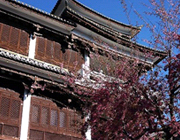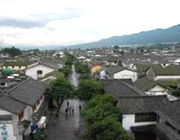Old Town of Dali
Dali municipality covers an area of 1,457 square km. and is inhabited by 400 thousand people, composed of the Bai, Han, Hui, Yi, Lisu and other nationalities, among whom the Bai nationality makes up 64% of the total. 
Its name is originated from that of a local regime in history called Kingdom Dali, meaning "a state of great order". Many of the architectures of the city were built of marble from the ore nearby, and that is why it is also called a city of Dali stone (marble). Marble buildings, marble streets, marble wall foundations and marble wells make the city so bright and limpid as if it is a tranquil fairyland.
Dali City stands against Cangshan Mountain in the west and adjoins Erhai Lake in the east, and is embraced by undulating hills around. Within the boundaries of Dali, there are many ancient pagodas, steles, places of historical interest and frescoes. The ancient Dali City is still standing there elegantly and toweringly. The most outstanding places of interest in Dali are: the ancient city proper of Dali, the Three Pagodas on the ruins of Chongshengsi Monastery, Nanzhao Stele, the Tablet Commemorating Kublai khans Conquest of Yunnan, the remains of Taihe City, the Tomb of Du Wenxiu, the scroll of pictorial history of Nanzhao (Tang Dynasty), Pictures on Buddhist themes Painted by Zhang Shengwan of Dali (Song Dynasty), and the Frescoes in Xingjiaosi Temple of Shaxi (Ming Dynasty). All these are the witnesses of the brilliant history of this ancient city.
The Butterfly Spring is twenty kilometers north of Dali on the slope of Yunnong Peak. Spring water gushes out from the roots of  a tree and flows into a clear pond. Beside the pond there is a huge camphor tree whose blossoms in April and May resemble butterflies, when thousands of real butterflies are attracted to the beautiful pool, too. Legend has it that the pond was originally called Bottomless Pond and that a pretty girl by the name of Wen Gu lived close by. Wen Gu was deeply in love with Xia Lang, who lived on Cangshan Mountain, and the two young people made solemn pledges of love by the Bottomless Pond. But the local despot Yu Wang wanted to have Wen Gu as his concubine. Finally, determined not to surrender, the lovers drowned themselves in the pond. Suddenly, a crack appeared at the bottom of the pool and a pair of beautiful butterflies emerged from the water. A host of other butterflies arrived and danced around them, and ever since the pond has been called Butterfly Spring.
a tree and flows into a clear pond. Beside the pond there is a huge camphor tree whose blossoms in April and May resemble butterflies, when thousands of real butterflies are attracted to the beautiful pool, too. Legend has it that the pond was originally called Bottomless Pond and that a pretty girl by the name of Wen Gu lived close by. Wen Gu was deeply in love with Xia Lang, who lived on Cangshan Mountain, and the two young people made solemn pledges of love by the Bottomless Pond. But the local despot Yu Wang wanted to have Wen Gu as his concubine. Finally, determined not to surrender, the lovers drowned themselves in the pond. Suddenly, a crack appeared at the bottom of the pool and a pair of beautiful butterflies emerged from the water. A host of other butterflies arrived and danced around them, and ever since the pond has been called Butterfly Spring.